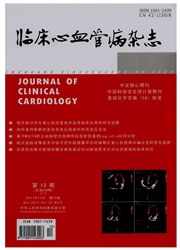

 中文摘要:
中文摘要:
目的:探讨1型多聚ADP核糖聚合酶(PARP-1)通过激活NF-κB调节体外培养乳鼠心脏成纤维细胞基质金属蛋白酶(MMP)~2,MMP-9酶活性的机制。方法:使用10/2mol/L去甲肾上腺素(NE)刺激体外培养的乳鼠心脏成纤维细胞24h,利用荧光基团DCF—DA检测心脏成纤维细胞内活性氧(ROS)水平,使用明胶酶谱法检测MMP-2,MMP-9的酶活性水平,凝胶阻滞实验检测NF-κB的DNA结合能力,Western-blot检测PARP-1蛋白表达水平;使用PARP-1抑制剂3一氨基苯甲酰胺(3AB),α、β受体阻滞剂及抗氧化剂vitC干预后,观察上述指标的变化。结果:NE诱导心脏成纤维细胞内ROS产生增加,PARP-1蛋白表达增加,NF-κB的核转录能力明显增强,MMP-2、MMP-9酶活性明显增加。使用3AB抑制PARP-1活性,或使用抗氧化剂vitC及α、β受体阻滞剂等预先处理后可显著抑制NF-κB的DNA结合能力,进而减少NE诱导的MMP-2,MMP-9酶活性。结论:NE诱导心脏成纤维细胞内ROS产生明显增多,ROS激活PARP-1并促使其蛋白表达显著增高,PARP-1通过增强NF-κB的DNA结合能力调控MMP2和MMP~9酶活性。
 英文摘要:
英文摘要:
Objective:To investigate the role of poly (ADP-ribose) polymerase-1 in regulation of the enymatic activities of MMPs through NF-κB pathway in cultured rat cardiac fibroblasts. Method:Cultured rat cardiac fibroblasts were divided into 6 groups. Group 1(control) :control group without treatments. Group 2(NE): treatment with NE (10 μmol/L)for 24 hours alone. Group 3 (3AB): pretreatment with 15 mmol/L 3-aminobenzamide (3AB) one hour earlier followed by NE (10 μmol/L) treatment for 24 hours. Group 4(vitC).. pretreatment with vitamin C (1.4 retool/L) one hour earlier followed by NE (10 μmol/L) treatment for 24 hours. ;Group5(α+NE) .. pretreatment with α receptor blocker phentolamine (10μmol/L) one hour earlier followed by NE (10μmol/L) treatment for 24 hours. Group6(β+NE) : pretreatment with 13 receptor blocker betaloc (10 μmol/L) one hour earlier followed by NE (10 μmol/L) treatment for 24 hours. Intracellular ROS level, PARP-1 expression, enzymic activity of MMP-2, MMP 9, and the DNA binding activity of NF-κB were measured by Fluoromax-3 spectrofluo- rimeter, western-blot, gel zymography, and electrophoretic mobility shift assay (EMSA), respectively. Result: PARP inhibitor 3AB, vitC, α,β blocker significantly prevented NE-induced increases in intracellular ROS level, the expression of PARP-1, the activity of MMP-2, MMP-9 in cardiac fibroblasts. Conclusion: Activation and overexpression of PARP-1 increases the enzymic activity of MMP-2, MMP-9 in NE-treated cardiac fibroblasts through promoting NF-κB DNA binding activity.
 同期刊论文项目
同期刊论文项目
 同项目期刊论文
同项目期刊论文
 期刊信息
期刊信息
